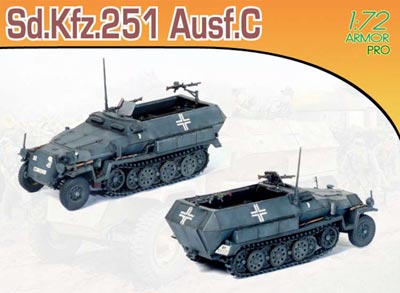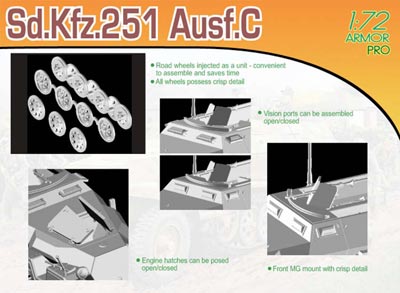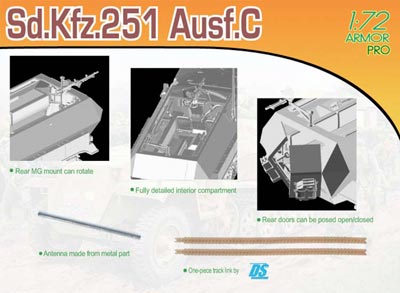| |
Dragon Sd.Kfz.251 Ausf.C (7223)
by Frank De Sisto

1/72-scale styrene/multimedia kit. Contains: 127 styrene plastic parts,
five photo-etched brass parts, one metal rod, two DS-100 parts, seven
decal marking schemes and eight pages of instructions in seven steps.
Anybody who has been paying attention knows that after a long dormant
period, small-scale AFV modeling has taken off like a rocket. Likewise,
anyone involved in the hobby of AFV modeling in general, knows that DML
has decided that it will go to great lengths to produce extraordinarily
detailed kits, both in 1/35th and the smaller 1/72nd-scales.

So, in conjunction with their large-scale brethren, DML has begun to
release a series of Sd.Kfz.251 kits in 1/72nd-scale. The first is the
“plain vanilla” ‘251/1, based on the Ausf.C chassis.
As such, this kit has details in its interior tailored for the standard
troop-carrying version. This includes a very nicely detailed driver’s
cockpit, including instrument panel, separate controls and steering wheel
(only the foot pedals are molded on to the deck), nicely detailed seats,
two-position vision blocks with internal detail, a radio, head pads and
various stowage items. Note also that the shape of the firewall, on the
driver’s side is correctly angled and the spurious water tank seen
in some of the large renditions of this vehicle (used only on the /8 Krankenpanzerwagen)
is absent. The troop compartment features rifles and their racks, bench
seats with locker details beneath them, MP40 and ammo racks, fire extinguishers,
and two-position rear doors complete with nicely represented hinges. The
rod mounted along the upper edge of the troop compartment is molded on
to the superstructure top part, while the internal mounting plate for
stowage and fittings is represented by a slightly raised area integral
with the main part.

External details include the shielded forward MG34 (with choice of etched
or styrene shield), rear-mounted AA MG34, tools, various light fittings,
fender-mounted storage lockers, antenna base featuring a metal rod for
the antenna, width indicator poles and turn signal indicators. The fenders
are one-piece affairs with part of the exhaust system molded in situ on
the port side. They feature fine rivet detail where appropriate. The engine
access doors are separate parts. A pair of nicely-rendered jerry cans,
in racks, is provided for use on the two rear doors. They are produced
using slide molds, so have nicely-represented handles with full undercutting
for maximum visual accuracy.
The hull belly and lower superstructure side panels are molded in one
piece, including the suspension swing arms. This will allow not only for
ease of assembly, but also (along with another innovation soon to be described)
will ensure that the basic parts of the hull, as well as the road wheels
themselves will be perfectly aligned. To further the cause, the road wheels
themselves are very cleverly molded. For instance, the inner and part
of the center sets of overlapping wheels are molded as one complete piece
for each side. To them are then attached the outer center road wheels,
which are also molded as one complete piece. Finally, individually-molded
outer road wheels are attached (featuring nice spot-weld detail around
the rims). Again, this considerably eases the alignment of many parts.
In this scale especially, if the road wheels are only slightly misaligned
they will be noticed. To this assembly is attached the DS-100 soft styrene
tracks, which can be fixed using standard styrene cements. The front wheels
have detail on both sides of the hub, while the steering axle is a multi-part
affair that includes the link from it to the steering column.
I checked the fit of the main components and everything seemed fine.
However I did not assemble the entire kit, so those who expect this to
be a full-build review may be disappointed. Overall, the detail of the
parts is quite fine and molding is delicate and crisp. Accuracy-wise,
I cannot say if the dimensions are correct or not as I have no 1/72nd-scale
plans to compare the kit to. It should be noted that the upper superstructure
does not overlap the lower superstructure plates where they join and that
the teeth on the drive sprockets are centered on each rim segment, rather
than off-set forward. In this scale, the latter may not be an issue with
most modelers; but the former may be. On the other hand, public feed-back
regarding the same issues on the larger-scale versions of this kit have
been extant for enough time that DML should have probably known about
them.
The decal sheet contains markings for seven specific vehicles. Three
are for the Grossdeutschland Division, two are for the 4.Panzer-Division,
and one is for the Panzer-Lehr-Division. The seventh is described as “unknown
unit eastern Front 1943”. The markings shown (“pregnant”
letter “D” with a horizontal stroke across the center) are
actually for the 21.Panzer-Division in North Africa. The decals are manufactured
by Cartograf of Italy and are cleanly printed with excellent color saturation
and registration. The sheets also include extra Tac numbers as well as
license plates that feature separate numerals as well as “WH”
and “SS” prefixes, enabling the
modeler to mark other vehicles
per references, as well as making them useful for a variety of other models.
This is only the tip of the Sd.Kfz.251 iceberg as DML have also announced
Ausf.A and Ausf.D versions of this vehicle. I compared this to the decades-old
ESCI kit, and there is really no comparison; this is a “new millennium”
kit for certain, warts and all. So, small-scale fans of this halftrack
should be quite content.
Recommended.
Reviewer’s note: Since May of 2005, I have been working on books
for Concord Publications, a sister company to DML. The reader may wish
to take this into consideration. For my part, I will attempt to maintain
an objective viewpoint when writing these reviews.
DML kits are available from retail and mail order shops. For details
see their web site at: www.dragonmodelsltd.com.
|
|